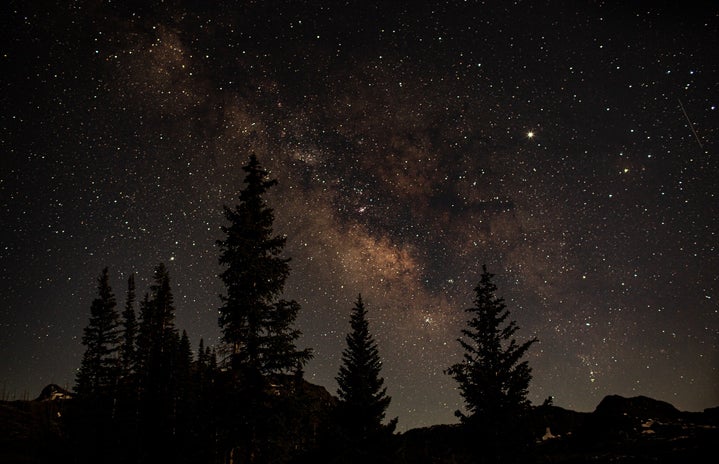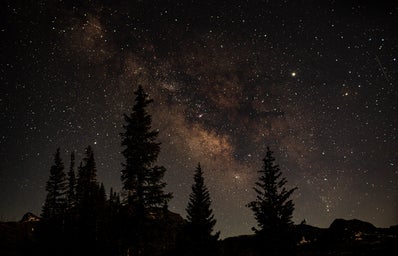Hello everyone! I hope everyone is having a calm start to the spring quarter. There is a lot happening this month in the night sky and I’m here to report it to you all.
Starting strong this month, April 5 marks the first day of the Qingming solar term in the Chinese lunisolar calendar. The new moon will occur on April 11. The next day marks the start of the month of Ramadan in the Islamic calendar as well as the beginning of the month of Iyar in the Hebrew calendar. On that same day, the night sky will be graced with a crescent moon. April 14 will be the day that the Moon will reach its Apogee, or the farthest part in its orbit from us here on Earth. On April 15 the star of Aldebaran will rise just left of the moon and will set at 11:05 EDT.
You can find Mars in the sky around the Moon on April 16 and 17, and on April 18 the Rust Planet will have its Superior Conjunction. On April 25-26, the star Spica will hang out just to the lower right of the Moon. Also on April 26, the Moon will be full and will appear full until about Wednesday. This month’s moon is called the Pink Moon. This is due to the appearance of “wild pink moss’ or wild ground phlox.
In addition to that, on April 22-23 the Lyrids Meteor shower will peak. Sadly, the almost full moon will practically obscure our view of it, but maybe in the early morning, if you wait long enough you may be able to catch a glimpse of the brightest ones. So, find the darkest patch in your city and be willing to wait a while.
Talking about shooting stars, two Near-Earth Objects will pass close to Earth around April 26. The NEO 2019 HF4 will pass by within a span of around 8 days around the expected date and is about 26 to 59 feet across (8 and 18 meters). The NEO 2015 HA177 will pass by within a span of about 4 days and is about 25 to 56 feet across (8 and 17 meters). Let’s hope they stay on the expected course.
If you happen to be wondering what constellations you can find in the night, Leo the lion will grace the stratosphere all month long. You can find it by the star Regulus that makes up its heart. NASA also confirms that at least two stars that make up the Leo constellation have confirmed exoplanets orbiting them. Another fun fact about the Leo constellation is that it’s star Algieba is a binary star system. There are many more constellations in the sky but in the city Leo might be the only one you can see.
If you noticed two weeks ago that the Moon was big and orange and were wondering why, I’m here to tell you. All light that we see coming from space is filtered through our atmosphere and that filter refracts much of the blue and green light coming from the white light our moon is reflecting. This means that the only light that makes it through our atmosphere is red and yellow light, so the moon appears orange to us. Now for the size thing, it entirely depends both on how close the moon is physically to us and how close to the horizon it is. You may wonder what the horizon has to do with the Moon. When the moon is closer to the horizon it’s also closer to the mountains, buildings, trees, and such which give us a perspective for the size of the moon. So, while you look at the moon next to a building as opposed to the semi empty sky it’ll look bigger. When there is a Supermoon it signifies that the Moon is at the closest point in its orbit to the Earth or its perigee so there will be days where the Moon looks bigger or smaller as it orbits closer or farther away from us here on Earth.
Do you want to know what they found out on Uranus? This past week NASA released a statement about our highly weird planetary neighbor. Scientists at NASA have recorded high amounts of X-Rays being emitted from Uranus. Now you see Uranus has always been a weird planet; it rotates on its side, the magnetic field is all wonky, its seasons are 20 years long, it’s the coldest planet despite not being the farthest from the Sun, and I could go on. This discovery of X-ray emissions is just another thing to add to the long list of oddities Uranus boasts. The Chandra X-Ray Observatory used observations of Uranus from 2002 and 2017 to study the phenomena. Their answer for some of the X-Rays is the Sun. X – Ray scattering is not an uncommon phenomenon and can be observed in planets like Jupiter and Saturn and even here on Earth but for Uranus there are some extra X-Rays that scientists don’t quite know how to explain. The research is still in its early stages and there will only be more information coming out as time progresses. Until then, Uranus will be the planet that has more questions than answers. To read the entire statement from NASA you can find it here.
So from me to you, I hope your April is treating you sweetly and the Spring is warm. Enjoy the stars and come back next month to find out about all the goings on for May.


